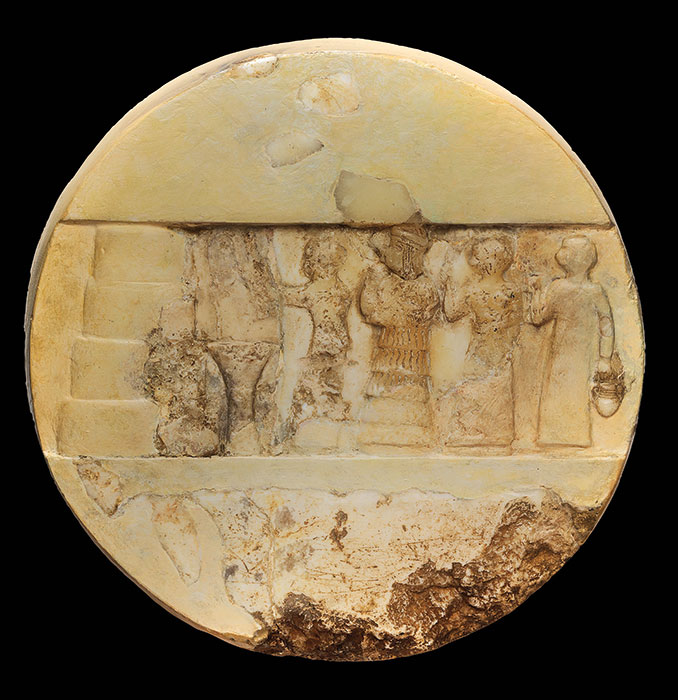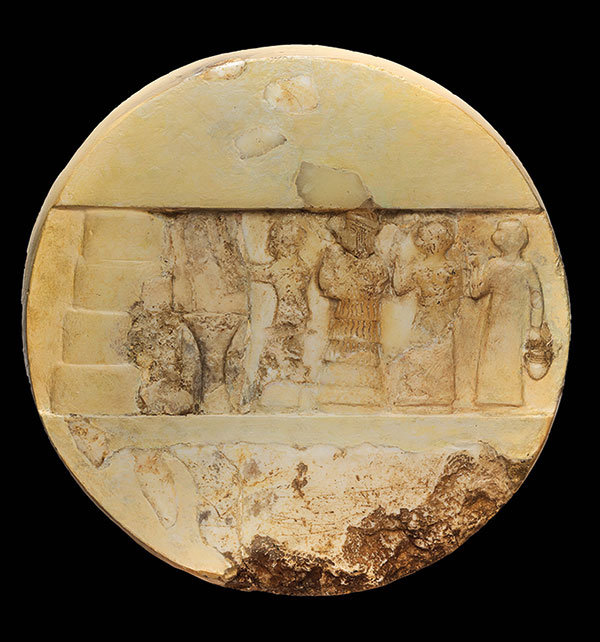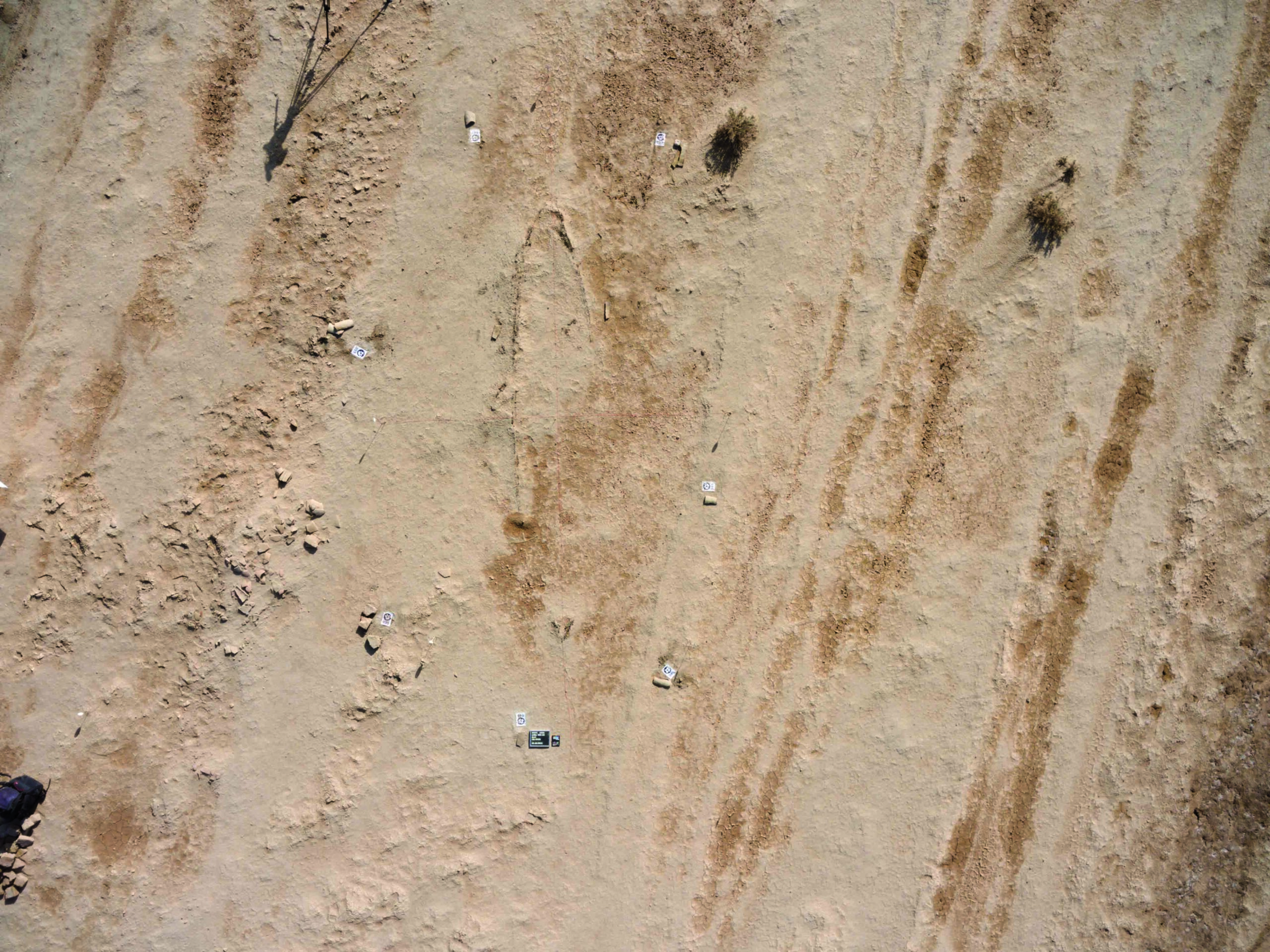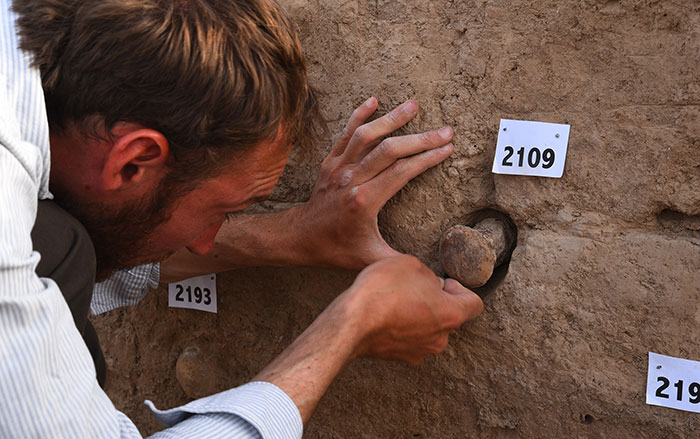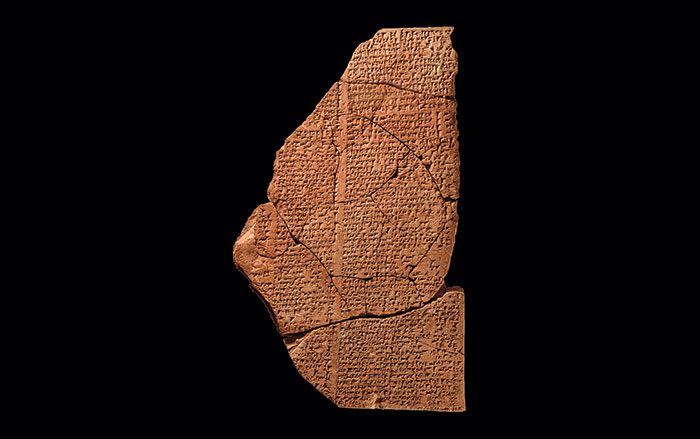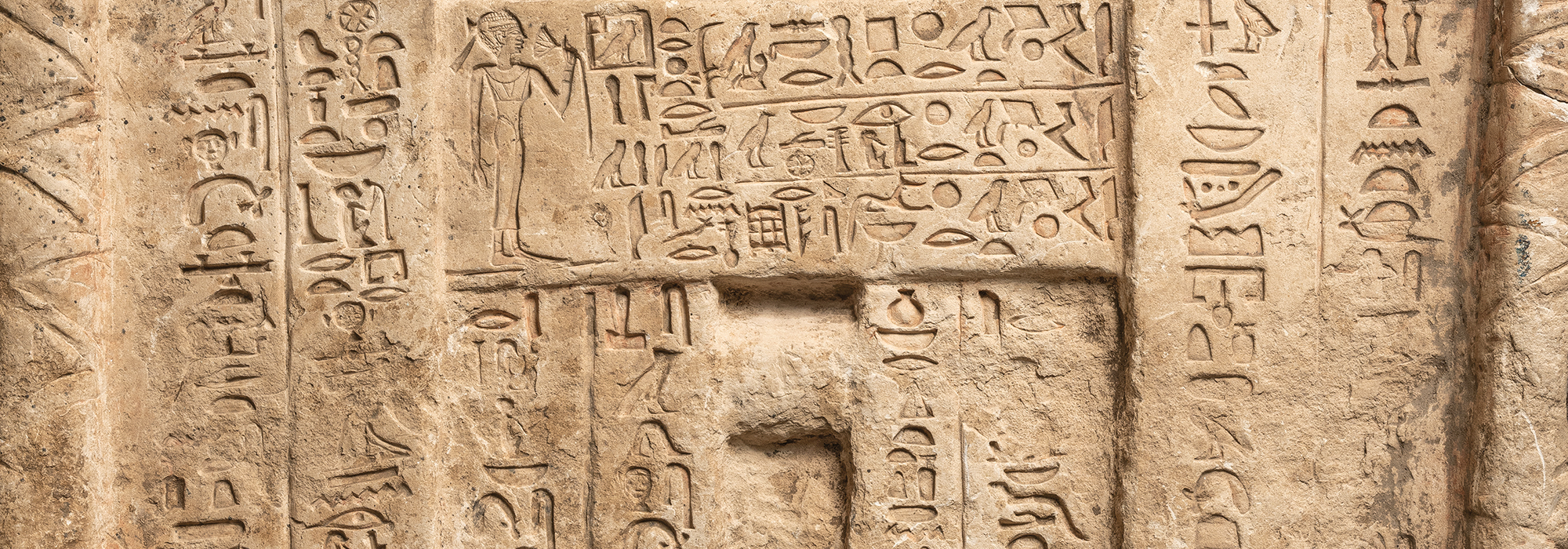
The name of the world’s first known author appears on the back of a 4,000-year-old white alabaster disk that resembles the moon. Uncovered in a temple in the ancient Sumerian city of Ur by archaeologist Leonard Woolley in 1927, the disk is decorated with a relief depicting four figures facing an altar. They appear to be participating in a sacred rite. One of the figures—a woman who wears a headdress and a layered gown—is larger than the others and seems to be in charge of the proceedings. An inscription identifies her as Enheduanna, priestess of the moon god Nanna, servant of the goddess Inanna, and daughter of Sargon, king of the world.
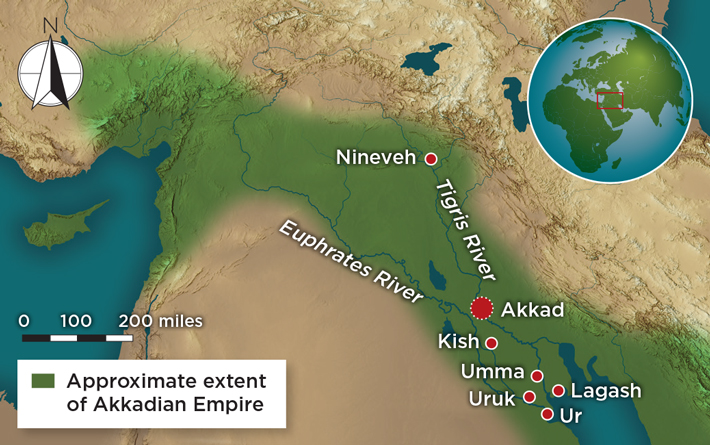
When the disk was unearthed, Assyriologists, scholars who specialize in ancient Mesopotamia, were already familiar with the historical figure of Enheduanna as the author of Sumerian songs and hymns dating to the Akkadian Empire (ca. 2350–2150 B.C.). Now they had a face to put to a once-famous name that was only then beginning to emerge from four millennia of obscurity. “It’s incredible,” says Yale University Assyriologist Benjamin Foster. “She’s the only author in the entirety of Sumerian literature whose name we actually know, and the only author in the entire 2,500-year span of Mesopotamian history of whom we have a contemporary illustration.”
Enheduanna’s father, Sargon the Great (r. ca. 2340–2285 B.C.), was the founder of the Akkadian Empire, the first state that brought multiple peoples, territories, and city-states under the same rule. The empire’s influence echoed through Mesopotamian history, with powerful leaders such as Hammurabi of Babylon (r. ca. 1792–1750 B.C.) and Sargon II of Assyria (r. 721–705 B.C.) modeling their reigns on those of early Akkadian rulers, who were known as members of the Dynasty of Ishtar, after their patron goddess.
Until now, Enheduanna’s role in maintaining the Akkadian Empire’s power has been overshadowed by the fact that she is history’s first known attributed author, but new analysis of her sacred songs demonstrates her central political role. “The rituals that Enheduanna performed were instrumental in creating the new power structure by reconciling the city-states and the wider realm,” says University of Göttingen Assyriologist Annette Zgoll. Her research has offered new interpretations of Enheduanna’s songs that are helping scholars understand how she became indispensable to Sargon’s heirs in their struggle to maintain power across Mesopotamia and as far away as the Mediterranean Sea. Enheduanna is now the focus of research aimed at understanding a historical figure who, while she lived, was critical to the Dynasty of Ishtar’s success—and was almost certainly the most powerful woman in the world.
Prior to the rise of the Akkadian Empire, Mesopotamia was divided into two regions occupied by distinct peoples—the Sumerians, who lived in dozens of independent city-states along the valleys of the Tigris and Euphrates Rivers in southern Mesopotamia, and the Akkadians, who occupied the more rugged reaches of northern Mesopotamia. Each Sumerian city-state was ruled by a king and centered on a temple dedicated to a patron god or goddess to whom its inhabitants were devoted. Two of the most prominent Sumerian city-states were Ur, which was watched over by Nanna, god of the moon, and Uruk, watched over by Inanna, goddess of love and war.
By contrast, the Akkadians believed that gods and goddesses were as numerous as the stars, and that they could change which deity they worshipped at any time, depending on the circumstances in which they found themselves. “This openness to new allegiances meant that when the Akkadians settled in different landscapes, they could introduce the gods who lived there into their spiritual horizon,” says Foster. “When other people came among them, new deities could set up dwellings in their heaven.” Despite worshipping many gods, the Akkadians acknowledged a supreme god, Il, and considered the goddess Ishtar—their equivalent to the Sumerian goddess Inanna—their national deity.
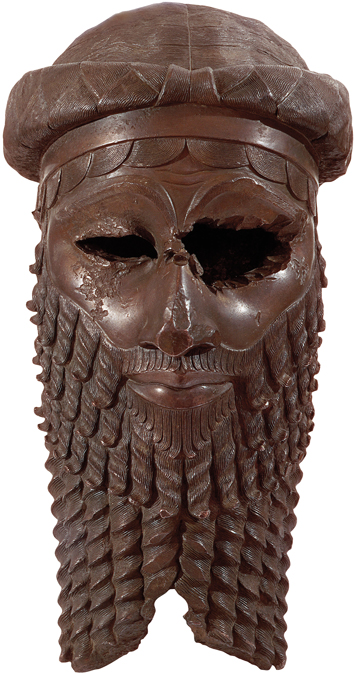
Until Sargon’s ascension, the Sumerians dominated culture and trade in Mesopotamia. By around 2370 B.C., the formidable king Lugalzagesi of Umma had taken command of Sumer by conquering neighboring cities such as Ur and Lagash. As Lugalzagesi rose to power in Sumer, he began to clash with the Akkadian king Ur-Zababa, ruler of the city of Kish, located on the Euphrates River around 50 miles south of present-day Baghdad.
During this time, according to legend, Sargon was born in secret in the city of Akkad to a priestess of the goddess Ishtar, who set him adrift on the Euphrates River where he was eventually found and adopted by a gardener living in Kish. Sargon became a cupbearer at the court of Ur-Zababa. “This allowed him direct access to the royal family, and it was an important role, giving him responsibility for the purity of foods served,” says Foster. The legend tells of a plot to murder Sargon that was thwarted by Inanna, demonstrating that the future king had divine protection. Sargon then overthrew Ur-Zababa, revealing an unprecedented appetite for power that would not be satisfied by becoming just the ruler of Kish. After establishing an extensive kingdom in northern Mesopotamia, Sargon went on to overthrow Ur-Zababa’s Sumerian nemesis Lugalzagesi and to conquer the Sumerian cities in the south, unifying all of Mesopotamia into one large state. “There was something special about Sargon,” says Foster. “For the first time in Mesopotamian history, a king didn’t spend his time fighting neighboring cities but turned his energies to foreign lands. No one had ever done this before.”
Sargon had established the world’s first empire, joining a range of ethnicities with different beliefs and different languages under the same ruler. The king, whose capital was the city of Akkad, the precise location of which is unknown, sent Akkadian governors to oversee Sumerian cities and made Akkadian the empire’s official language. According to administrative documents, Sargon maintained a force of 5,400 men, the world’s first professional standing army.
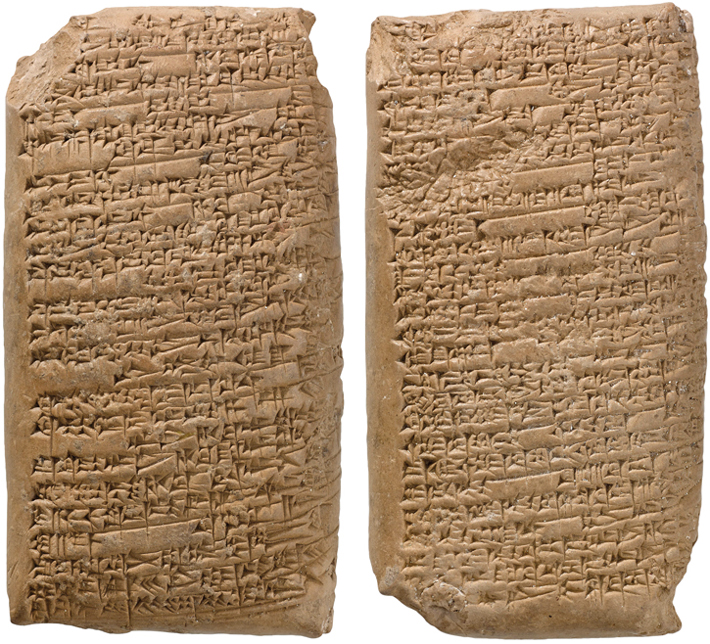
He was in need of a reliable fighting force—the Sumerians did not submit willingly to Akkadian rule. “We know that the Sumerian cities revolted at least twice and that their rebellions were suppressed bloodily, with body counts in the tens of thousands— as much as one-third of the male population of fighting age,” says Assyriologist Ingo Schrakamp of the Free University of Berlin. The Akkadian army, outfitted with sophisticated weapons such as powerful composite bows, was always able to overpower the Sumerian forces, which were assembled from farmers and shepherds armed with simple lances, axes, and spears.
The Sumerian King List, a text whose earliest version dates to around 2000 B.C., charts the rise and fall of the Akkadian Empire, which began with Sargon and grew in the hands of his grandson Naram-Sin (r. ca. 2260–2223 B.C.) and his great-grandson Sharkalisharri (r. ca. 2223–2198 B.C.). Upon Sharkalisharri’s death, the empire collapsed, losing the Sumerian south. It continued as a regional northern state before coming to an end. But before the Dynasty of Ishtar fell, its rulers oversaw startling innovations in arts and literature throughout Mesopotamia. Artisans who had previously created abstract and geometric sculptures began to produce detailed figures, with faces expressing individual personalities. A regal copper head found in the ancient city of Nineveh provides a classic example: With a strong gaze, elaborate coiffure, and carefully groomed beard, the sculpture projects power, and may even depict Sargon himself.
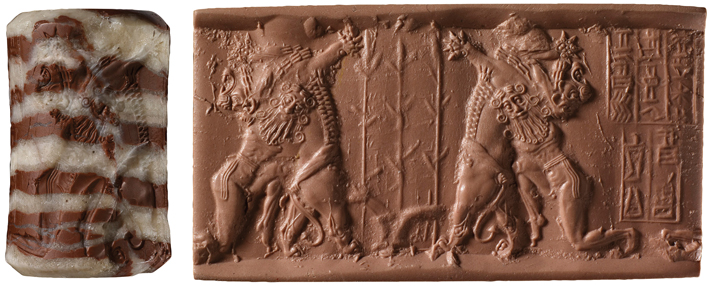
Reliefs such as the disk depicting Enheduanna and her assistants as well as engraved stone cylinder seals form the largest body of art from the Akkadian period. Rather than the softer local stone used in the pre-empire period, Akkadian imperial seals were commonly carved in serpentine—a more valuable stone that was much harder to work with. Akkadian artisans depicted dramatic events such as battles that pitted heroes against animals. A seal found in the cemetery of Ur that belonged to Enheduanna’s official hairdresser shows just such a scene.

The poetry of Enheduanna, which evokes powerful feelings and records her innermost thoughts, paralleled the revolution in the visual arts. Her work gives scholars a window into rarefied religious and political beliefs of the time, but archaeologists have gleaned the majority of their insights into Akkadian life from a group of about 8,000 more prosaic cuneiform texts written in Akkadian and Sumerian on clay tablets. These include a large group of royal inscriptions and thousands of documents that record trading transactions and legal matters. “The royal inscriptions tell us what the Akkadian kings thought was important about themselves,” says Foster, “while the administrative documents give a picture of the empire’s day-to-day operation.” But Assyriologists still have only a hazy picture of how Sargon built and maintained his empire. “Did the Akkadian Empire happen by accident, because neighbors kept doing foolish things, or was there a grand plan?” wonders Foster. “We just don’t know enough.”
Scholars believe that one way Sargon maintained his vast empire was by appointing members of the royal family to high priesthoods, beginning with his daughter, Enheduanna, whom he appointed as high priestess of the Sumerian moon god Nanna in the city of Ur. “I think this was a stroke of genius,” says Foster. “He made religion and the state into family affairs.”
High priests and priestesses were responsible for ritual ceremonies and for writing and performing new poems in praise of the gods. This prestigious position gave Enheduanna an outlet for her literary talents. Although Akkadian is thought to have been her first language, Enheduanna wrote in Sumerian, the language of the south. Uniquely for her time, she declares her authorship and names herself “I, Enheduanna” in the text of two songs praising Inanna. One of these, known as “Ninmeshara,” which Zgoll translates as “Inanna, Lady of the Countless Instruments of Power,” narrates events that occurred when the Sumerians revolted against Enheduanna’s nephew, Naram-Sin. “Ninmeshara” has long been revered as an important sacred scripture in Mesopotamia, and some 100 clay tablet versions of it exist, all of which postdate Enheduanna’s death and were copied or recopied up to 500 years after she wrote the song. In addition to “Ninmeshara,” Enheduanna is credited with writing the so-called Temple Hymns, a cycle consisting of 42 short poems, each dedicated to a single city god and its temple.
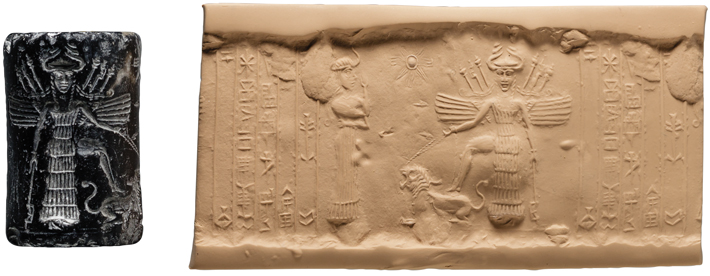
Elucidating meaning from Enheduanna’s works has proved difficult for scholars. Akkadian was a Semitic language, related to modern Arabic and Hebrew, but Sumerian died out long ago and does not belong to any known language family. “Sumerian doesn’t have a modern relative, which means we can’t trace the etymology of words and we have no lexicon for it yet,” says Schrakamp. Further complicating efforts at translation is the fact that Enheduanna used a highly complex form of Sumerian, employing words that are found only in her poems, intricate syntactical structures, and many abbreviations. Enheduanna’s style of writing is also highly poetic, rich in metaphors and full of stylistic devices, with a complex narrative structure and many hidden meanings. “It’s considered to be some of the most difficult text handed down in the literature of the Sumerian language,” says Zgoll.
Zgoll has made a significant breakthrough in understanding Enheduanna’s works by breaking the text down into its smallest meaningful units, known as “hylemes.” An example from “Ninmeshara” reading “Queen, greater than the hostile lands—who would dare take any of your territories away from you?” contains three hylemes. They allow three pieces of information to be inferred: “Inanna is queen,” “Inanna is more powerful than the hostile land,” and “no one can steal territories from Inanna.” Applying this technique to the whole text, Zgoll has gained insight not only into myths that Enheduanna incorporated in “Ninmeshara,” but also into the political events that motivated her to write the song and how it would have been interpreted by people at that time.

The context of the song suggests that Enheduanna wrote “Ninmeshara” when the Akkadian Empire was on the brink of collapse. Civil war was raging, and Naram-Sin was in acute danger. Enheduanna herself had been forced to flee Ur and go into exile, probably in the city of Lagash to the north. According to the song, the moon god Nanna failed to aid her in her hour of need. Enheduanna turned instead to Inanna, who by then had been merged with Ishtar and become the patron deity of the empire.
Enheduanna uses an intimate tone to appeal to the goddess, suggesting that the poem was initially composed as a private and personal conversation between Inanna and the poet, who likely performed it in an empty room within the temple. “There may have been some musicians accompanying her on the lyre, but no human audience,” says Zgoll. Afterward Enheduanna may have sung the poem to an elite audience of the Sumerian priests she was meant to control and influence, but ordinary people would never have heard it. “Temple rituals were only intended for the gods and people who were initiated,” Zgoll says.
Immersing herself in Enheduanna’s words has given Zgoll a glimpse of how Mesopotamians perceived their reality. “This is a world that is really focused on gods and their demands and needs,” says Zgoll. “All these different myths tell us how humans were created in order to serve the gods—to feed them, clothe them, and make music for them.” People believed that the gods were responsible for their success and that rituals such as the performance of Enheduanna’s song “Ninmeshara” were an essential part of placating them and winning them to one’s side. “We can read between the lines of ‘Ninmeshara’ and see that Enheduanna is afraid of Inanna,” Zgoll says. “She understands that the goddess might be angry with her and she asks herself, ‘What have I done wrong? How is it that horrible things are happening to me?’”

"Ninmeshara” begins with a description of Inanna’s conquest of her enemies. This suggests to Zgoll that the events described in the poem as it survives may not reflect the original order of the text as Enheduanna composed it. “A Mesopotamian myth doesn’t normally forgo a proper introduction,” she says. “We don’t know why she conquers her enemies, so a prior event must have occurred.” By analyzing the text’s hylemes, Zgoll has been able to piece together the events making up the story, rearranging them into what she believes to be their original chronological order. This fresh structure has enabled her to locate places where information is missing but implied from surrounding text or cultural context.
In its rearranged form “Ninmeshara” begins with the god An, the Sumerian equivalent of the Akkadian god Il, giving Inanna the instruments of power. These were sacred weapons that allowed her to control fire, generate storms, ride on fearsome predators, and unleash terrifying disasters. The poem describes how enemies arise from Sumer, a reference to the well-attested Sumerian revolt during the reign of Naram-Sin. An and Enlil, god of wind, air, earth, and storms, pass judgment on the Sumerian rebels. Inanna then uses her instruments of power to destroy her enemies and become sovereign of all lands. “We can see that the song is a device for the mutual empowerment of the goddess and Enheduanna, her priestly human servant, in the hopes of resolving a critical political situation that affects events both in heaven and on Earth,” says Zgoll. “It ends with Inanna being the most powerful deity of all.”
Zgoll’s new translation gives fresh insight into the techniques the Akkadian political elite used to govern Sumer. “When Sargon conquered the south, taking the land and installing his own governors, it would have been perceived by the Sumerians as stealing divinely owned property from the city gods,” says Schrakamp. Enheduanna’s main role, along with her counterparts appointed as high priests and priestesses in other Sumerian cities, was to control local clerics, weaken the status of the city gods, and impose the Akkadian religious hierarchy on Sumer. “She really believed in her mission, believed in the Akkadian Empire, believed in the passion of Inanna, and believed that any rebels should be brought to a horrible end,” says Foster. “She was a very bloodthirsty poet.”
Her relationship to the goddess Inanna was key to Enheduanna’s own political role in the wake of the failed revolt. “By evoking myths about a forceful, victorious Inanna, Enheduanna declares that Inanna, who used to be a minor goddess, has managed to surpass the other deities,” Zgoll says. “All of them are now submitted to her authority.” This intentional subordination of the Sumerian city gods in favor of the Akkadian national deity, Inanna, is further confirmed by a previously unknown myth referenced in some of the passages of “Ninmeshara.” Those passages refer to a hostile city overseen by Nanna and prophesy that Inanna will order Nanna to deliver terrible famine, fire, and suffering to its citizens if they continue to rebel. “This suggests that the unnamed hostile city is Ur,” says Zgoll, “and that it will be subdued by its own city god, Nanna, and will belong to Inanna.”
Enheduanna’s reluctance to name Ur directly and the cautious and roundabout way in which she tells this part of the story is no surprise given that, at the time of its composition, she was in exile from Ur and her future was precarious. In Zgoll’s reconstruction of this previously unknown segment, Inanna passes judgment on Ur and orders Nanna to execute that judgment. As a result, the city has no food, its gates are burned, and Akkadian soldiers swarm in and conquer it. Once again, Inanna is proclaimed ruler of all the lands. In the words of the poem, “The judgment is yours [Inanna], my Queen! Since that has made you even greater, since you have become the most powerful.”
As “Ninmeshara” and Enheduanna’s other poems reveal, military prowess only partially explains the success of the Akkadian Empire. Unifying the state under one overarching religion was crucial, too. Enheduanna’s Temple Hymns are evidence that she was essential to this restructuring of society. Each of the 42 hymns is about one city god and its temple and fits the Sumerian concept that every city was autonomous. But taken together, the hymns form a narrative that exalts the unity of a single state. “Enheduanna’s Temple Hymns helped to build this concept that was so fundamental for the realm,” says Zgoll.
Enheduanna’s songs confirm that Sargon’s imperial strategy went far beyond the act of conquest. “This was a family that believed in communication and believed in the force of ideology,” Foster says. “They had thought clearly about what it could do.” The elite Sumerian subjects of the Akkadian Empire who heard Enheduanna’s hymns and her songs praising the newly ascendant Inanna would have understood that a new order was at hand. It respected their city gods but subordinated the Sumerians to a greater imperial and religious power.
Enheduanna’s song praising Inanna also resonated with later generations of Mesopotamians, most of whom came to speak Akkadian as Sumerian died out, and who regarded the failed rebellion against Naram-Sin as a foundational historical event. The song also became a model of how to interact with the most powerful gods. “For the Akkadians, a ritual involving a song of praise was a crucial means of interaction with the mightiest entities in the universe, who were presumed to have the power to change the course of history,” says Zgoll. By invoking Inanna in the Akkadian Empire’s moment of peril, Enheduanna claimed her place in history not only as the world’s first author, but as a poet who helped ensure the survival of its earliest empire.


